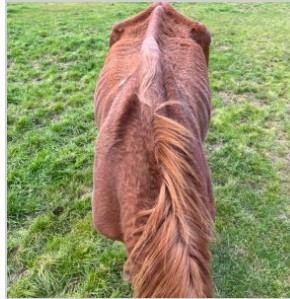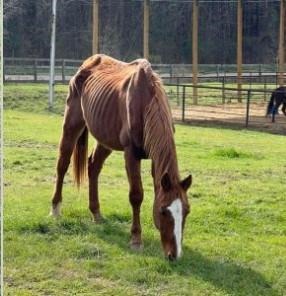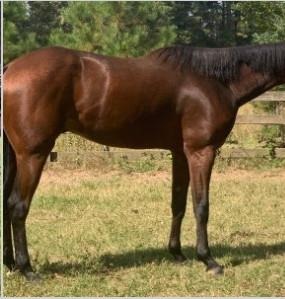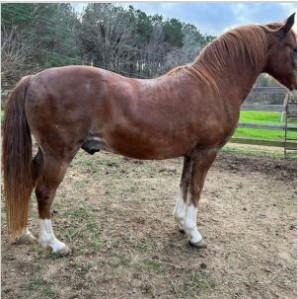The body condition scoring (BCS) system was developed by Don Henneke in 1983 during his Ph.D. program at Texas A&M University. Although this system originated via a project featuring non-pregnant mares, this is a universal system for all classes of horses. This scoring system is based on the amount of fat deposition or cover on an individual animal. Evaluating a horse’s current BCS is a valuable tool that allows insight into the horse’s general health. It also helps assess if the nutrition program that is being implemented is working. This is an important topic of understanding for any equine owner, breeder, manager, or competitor.

Figure 1. Areas of reference for body condition scoring.
Body Condition Scoring System Basics
The BCS system is a numerical 1 to 9 scale, with 1 being a poor animal that is extremely emaciated and 9 being an extremely fat animal. These scores are determined by both visual and tactile (touch) appraisal of six specific regions of the horse: along the neck, along the withers, behind the shoulder, across the ribs, crease down the back, and around the tailhead (figure 1). Remember, this is evaluating only the fat cover on the horse, not muscle tone. Although people can get an estimate of BCS by looking at a horse, to assess the score accurately, the horse should be touched to assess fat deposition. The horse should be standing still and square when being evaluated.
To increase accuracy when assigning numerical values, it is helpful to have an experienced person to standardize the scores. The more horses a person assesses of varying condition scores, the better. This is because although the scoring system is widely used, there is subjectivity. Additionally, reading the definitions provided for each score can help people improve the accuracy of their scores (table 1). There is no perfect mathematical formula to determine the BCS of a horse. Fat deposition may vary in each horse evaluated because of differences in breed or sex (for example, draft horses and stallions often have cresty necks). Because of this, some people prefer to use half-point increments (4.5, 5.5, etc.) to describe the BCS of their horse. A good starting place is to look and feel over the ribcage. A horse with at least a faint outline of ribs visible will most likely fall under a BCS of 5.
Table 1. Description of Individual Body Condition Scores (BCS)
Adapted from Henneke et al. (1983)
High, Low, or Just Right?
The ideal body condition score will vary depending on the class of horse being evaluated. In general, a BCS of 5 to 6 is considered healthy. However, there are numerous disciplines where a BCS of 4 is acceptable, such as elite racehorses and endurance horses. These horses are not unhealthy, but rather carry less fat for their discipline, which has the potential to slow these horses down. It is, however, important to understand the pros and cons of horses in high and low BCS extremes.
As many equine producers would expect, a horse that is too thin is certainly problematic. Thin performance horses do not have energy reserves to pull from during intense work, thus reducing work output. These horses may also be more prone to fatigue-related injury. Reproductive problems also exist for mares that are too thin, with thin females having longer interovulatory intervals, decreased pregnancy rates, decreased ovarian activity, delay in the seasonal onset of estrus and ovulation, and an increased number of cycles to conception. Because of these numerous detriments to thin horses, especially in terms of reproduction, it is advised for mares to enter the breeding season at a BCS of between 5 and 6.5. Producers should expect a mare to lose condition during lactation, so ensuring appropriate BCS at the time of foaling can help prevent the mare from falling below a 5 during lactation, which may affect rebreeding.

Figure 2. A horse with a BCS of 1 that was a neglect case. Notice the very prominent “negative crease” created by a lack of fat deposition around the spinous processes.

Figure 3. A horse with a BCS of 1 that was a neglect care. Notice the very prominent “negative crease” created by a lack of fat deposition around the spinous processes.

Figure 4. A horse with a BCS of 5. You cannot see the ribs and the neck, shoulders, and withers blend smoothly into the body.

Figure 5. A horse with a BCS of 8-9. This would be an instance where feeling fat deposition can help determine the BCS. The horse has a large amount of fat deposition over the crest of the neck, as well as patchy fat seen around the tailhead and ribs.
An old saying goes “the best color of horse is fat.” Recent evidence even suggests that horse show judges are more likely to penalize a horse that is too thin over one that is too fat. Although many people believe that there is no detriment to an over-conditioned horse (7 or greater BCS), there are many downsides. Performance horses that are obese will exert extra stress on their joints and may be more at risk for injury as well as heat or exercise intolerance. Obesity also increases inflammation and increases a horse’s risk for equine metabolic syndrome, insulin dysregulation, altered glucose dynamics, and laminitis. Mares that are over-conditioned do not demonstrate adverse effects on reproductive performance like seen in cattle, but research has shown that over-nutrition during late gestation alters maternal insulin sensitivity and foal pancreas cell structure, muscle fibers, and cell signaling. On a more practical side, keeping a horse over-conditioned can be financially wasteful, resulting in more money spent to achieve a higher BCS.
Changing Body Condition Scores
It takes time to change a horse’s BCS, but it is possible by paying attention to exercise and dietary needs. Working with a veterinarian and equine nutritionist can help determine the best course of action for achieving an appropriate BCS, as challenges exist regarding secondary morbidities such as a laminitis. In general, horses that are obese should have a gradual increase in exercise and a decrease in digestible energy. This can be achieved by monitoring what the horse eats and, depending on the situation, restricting intake by use of a grazing muzzle, dry lot, or weighing hay.
Thin horses should receive gradual dietary alterations. Horses in a chronic nutrient deficit state may suffer from refeeding syndrome if reintroduced to rich feeds too rapidly. The University of California, Davis evaluated refeeding emaciated horses using three different diets and created a protocol called “UC Davis’ Recommendations for Refeeding a Starved Horse,” which is commonly called “The Emaciated Horse Diet.” This protocol is widely used by equine rescue organizations, veterinarians, and nutritionists in cases of severe emaciation and outlines feeding an alfalfa hay-only diet.
Body Condition Score Take-Aways
Utilizing the BCS system is a practical and important option for assessing the nutritional status and general health of a horse. Most horses have an ideal BCS of 5 to 6 on a 1 to 9 scale, but this may vary depending on the horse’s use or discipline. To accurately assess a horse’s BCS, owners might enlist the help of someone experienced in the scale and remember to both look and feel your horse. Remember that extremes on either side of the scale have negative consequences. If an owner discovers that their horse is too high or low in BCS, they should make gradual changes over the course of 4 to 6 weeks per 1 point change, ideally under the guidance of a veterinarian or equine nutritionist.
Source : aces.edu